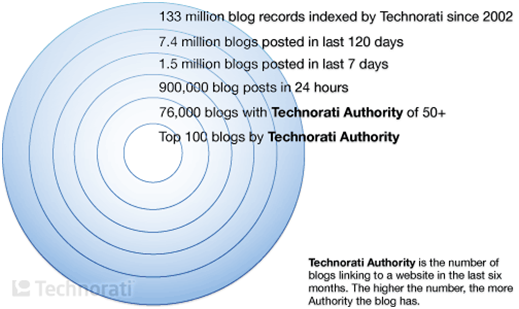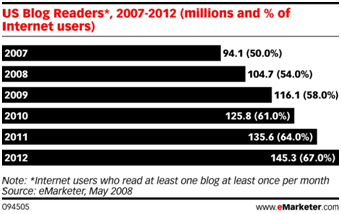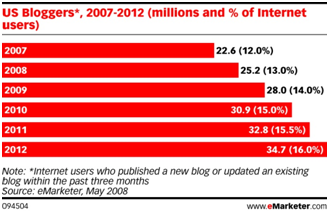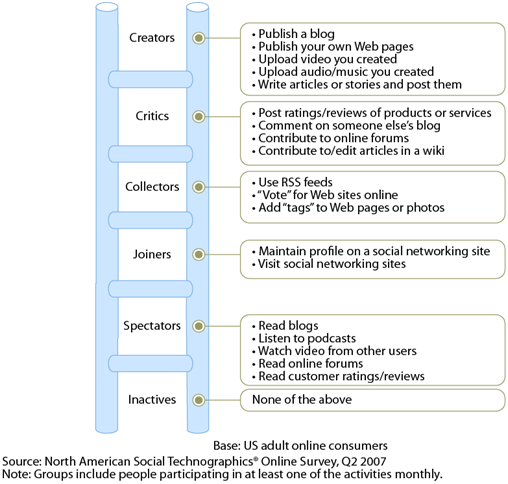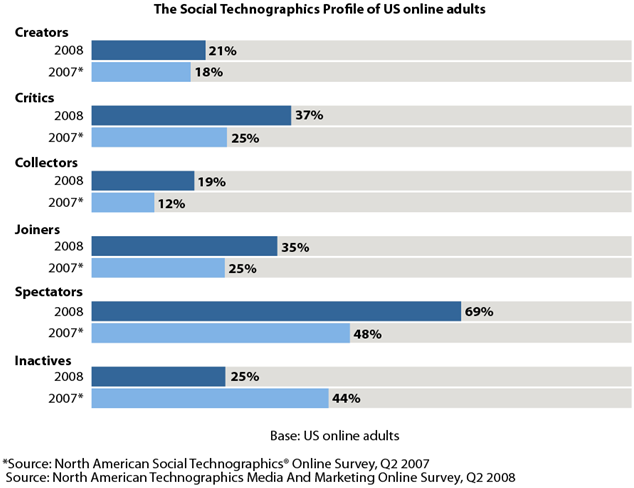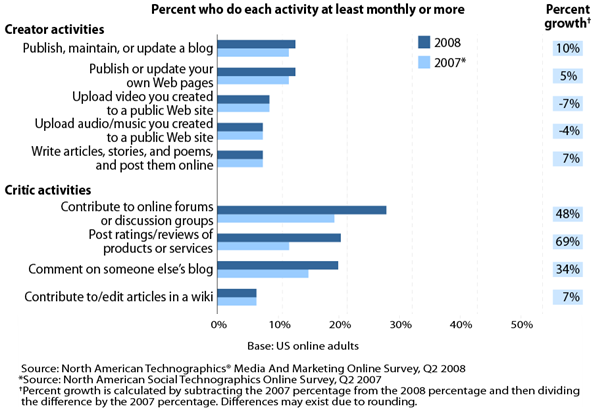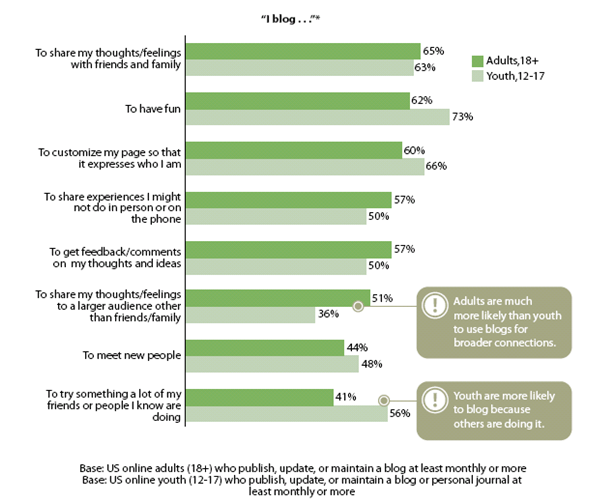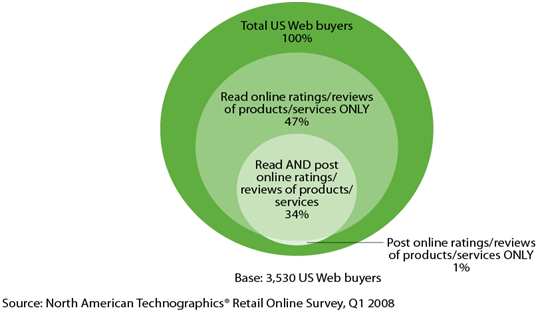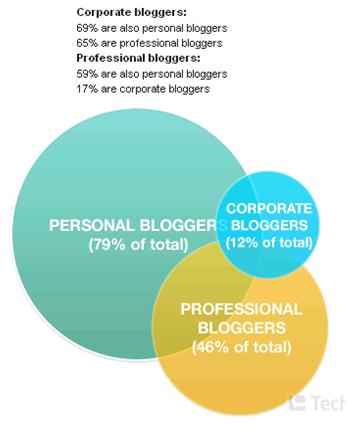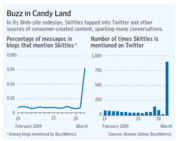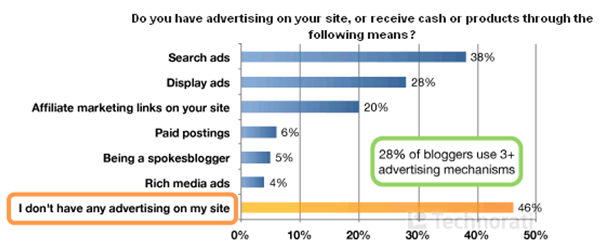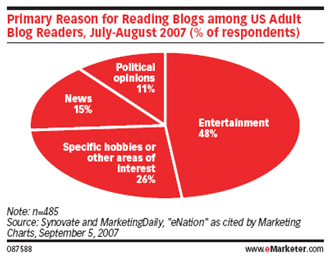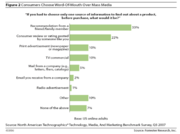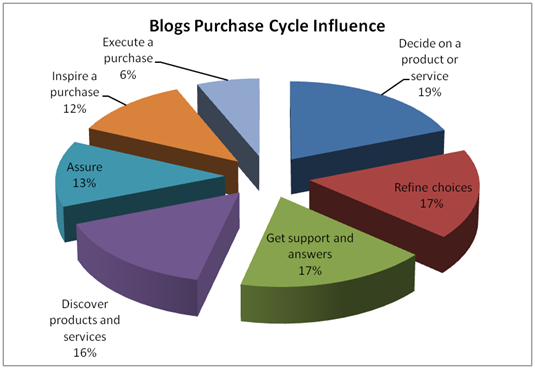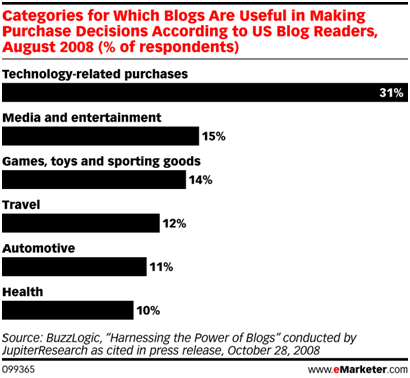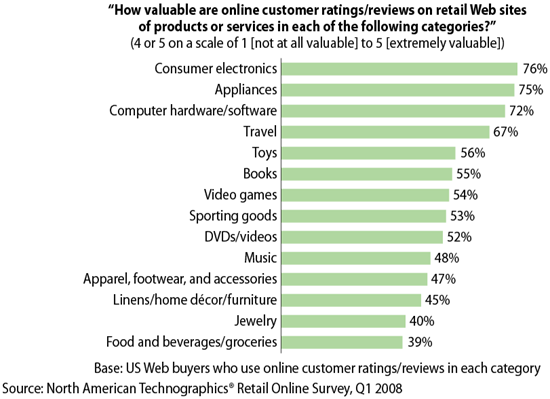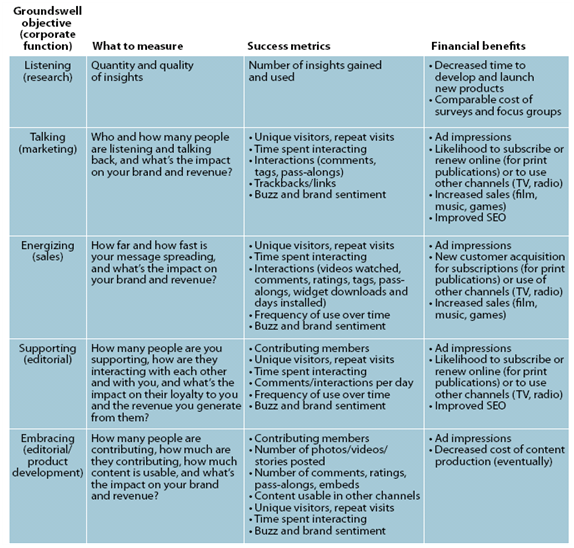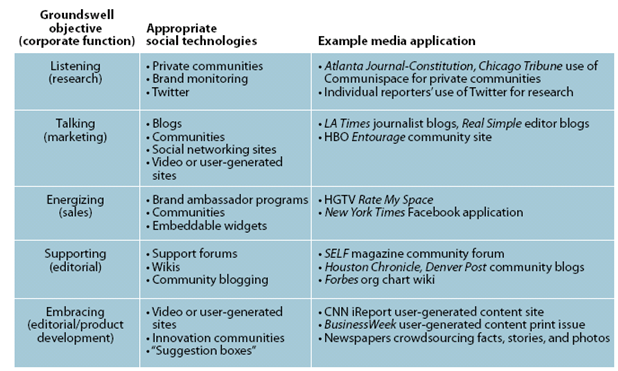Marketing in the Blogosphere
From The Yaffe Center
This page is under construction
Contents |
Acknowledgements
This page is largely adapted from "Joining the Conversation: Marketers, Meet the Blogosphere" written by Elizabeth K B Smith as a student at the University of Michigan Stephen M. Ross School of Business.
What is the Blogosphere?
“[B]rands make up a major part of bloggers' online conversations. More than four in five bloggers post product or brand reviews, and blog about brands they love or hate.” (Technorati 2008)
Although many definitions of (we)blogs exist, the most basic explains that a blog is an online platform that enables one to write without format constriction, word choice, or topic; it can be updated as frequently as wanted and is generally displayed in reverse chronological order. (Wikipedia n.d.) At its broadest, blogging can include online collections of entries from a specific author (e.g., through web-publishing services such as Blogger.com or Wordpress.com), sites featuring collections of writers focusing on broad topics (e.g., Engadget.com for consumer electronics or HuffingtonPost.com for aggregated news topics), social networking sites (e.g., Facebook.com or Twitter.com), or even user-generated reviews on retail or product-based websites, as pioneered by Amazon.com.
The blogger community generally thrives on reciprocity, trust, transparency, and authenticity.
Who is Blogging
The blogging community consists of people generally engaged in one of two activities: writing blogs and reading blogs. As discussed below, there is a large overlap between these two activities, but we will refer to those writing blogs as "bloggers" and those reading blogs as "readers." In 2008, eMarketer reported that the US had 25 million bloggers and 104 million blog readers. (eMarketer 2008)
"As early adopters, bloggers spend twice as much time online as U.S. adults 18-49, and spend only one-third as much time watching television. While they are online, bloggers are participating in an average of five “Web 2.0” activities such as RSS and Twitter. Bloggers are important to watch, as they are generally the first ones to use new web applications, and are highly influential in speeding adoption." (Technorati 2008)
Although bloggers themselves may be early adopters, their readership (at 50% of the 200 million US online population) is not necessarily as innovative. The popularity of blogs has increased significantly over the past several years, with 346 million people worldwide reading a blog in the past month (about 34% of worldwide internet population) and 184 million reporting that they have started a blog (18% of worldwide internet population). (Technorati 2008) Similarly in the US, eMarketer reports 104 million blog readers (54% of US online population that read once a month) and 25.2 million (13% of US online population) bloggers in May 2008. (Technorati 2008) Moreover, eMarketer expects readership in the US to reach 145.3 million (64% of US Online population) and the number of bloggers to be 34.7 million (16% of US Online population) by 2012 (see charts below). (eMarketer 2008) With readership increasing faster than authorship, the reach of blogs is growing more quickly than the number of blogs out there.
To better understand the discrepancy in blog readership as compared to blog writers, it is important to analyze the behavioral segments across social media. Charlene Li and Josh Bernoff’s “Social Technographics” studies are particularly insightful when reviewing levels of participation in social media and are currently regarded as the most complete framework for reviewing this phenomenon within Web 2.0 literature. (Reviews of Groundswell) The Social Technographics Ladder below illustrates the degrees of activity from participants across social media. Ranging from inactivity (“inactives”) to hyperactivity (“creators”), the largest group (48%) of US online adults are “spectators,” meaning they “consume what others produce.” (Li and Bernoff, Groundswell:Winning in a World Transformed by Social Technologies 2008, 45)
Because they are interacting with a range of brands and products, as opposed to bloggers who may focus their writing on one product category or topic, these critics illustrate a more holistic view of a target consumer across various participation points in the blogosphere. Furthermore, this group has shown considerable growth in participation from 2007-2008, indicating that the fear of participating has dissipated and/or that more sites are providing the infrastructure to facilitate these types of discussions (i.e. comment text boxes, 5-star rating systems, emails directing consumers to review a product they just purchased, etc). Specifically, from 2007-2008, the number of critics posting ratings/reviews grew 69% and those commenting on someone else’s blog grew 34% (see table below). Interestingly, critics have the option of remaining anonymous or posting with a profile that obscures their identity. Whereas maintaining a consistently credible identity is critical to the success of a blog (as discussed below), anonymity is acceptable for a critic. Thus, the reward value of being a critic is much higher than the perceived risk of participation which begins to explain the significant growth of critic activities as compared to creator activities illustrated below.
Interestingly, the number one reason adults (65%) blog is to “share my thoughts and feelings with family and friends;” yet, 57% of US adults also say that they blog “to share experiences I might not do in person or on the phone” (see chart below). While blogging is a public forum, these adults imply that they believe that blogging allows them some protection or anonymity that they cannot experience either in person or on the phone. This insight, however, counters Danielle Smith’s assertion that consistency, transparency and authenticity are what drive engagement. (Smith 2009) Therefore, to solve this paradox and translate this into useful information for a marketing manager, one may assume that bloggers create a new personal brand through their blogs. As Smith asserted, her offline friends do not participate in social media at all, yet she manages to find thousands of other women online that are conversing through social media. While this does not necessarily mean that Smith maintains separate personalities in her off and online worlds, it does suggest that incorporating social media usage can be an important characteristic in segmenting various markets.
A specific type of blogosphere activity, user-generated reviews, has become increasingly popular across various industries and product categories in the past five years. Following Amazon’s innovation, as Forrester Research asserts, “One in two online retailers currently features online ratings and reviews on its product pages;” and, “roughly four in five Web buyers have read online reviews on retail sites, and more than one-third have posted their thoughts” (see graphic below). (Mulpuru and Hult 2008)
Segmentation of Bloggers
"Bloggers are not a homogenous group, but they are an educated and affluent one: three out of four U.S. bloggers are college graduates, and 42% have attended graduate school. They skew male, and more than half have a household income over $75,000." (Technorati 2008)
Traditional segmentation, such as geographic segmentation, loses relevance with respect to bloggers as they lack geographic homogeneity. More relevant segmentation should focus on the personality, wants, desires and needs of the blogger/blog and the topics covered within the posts. Similarly, when conducting research and/or focus groups, marketers should include questions to determine how vocal each participant is and the extent to which he/she participates in social media.
| Demographics | U.S. Bloggers
(N=550) | European Bloggers
(N=350) | Asian Bloggers
(N=173) |
|---|---|---|---|
| Male | 57% | 73% | 73% |
| Age: 18-34 years old | 42% | 48% | 73% |
| Age: 35+ | 58% | 52% | 27% |
| Single | 26% | 31% | 57% |
| Employed full-time | 56% | 53% | 45% |
| Household income >$75,000 | 51% | 34% | 9% |
| College graduate | 74% | 67% | 69% |
| Average blogging tenure (months) | 35 | 33 | 30 |
| Median Annual Investment | $80 | $15 | $30 |
| Median Annual Revenue | $200 | $200 | $120 |
| % Blogs with advertising | 52% | 50% | 60% |
| Average Monthly Unique Visitors | 18,000 | 24,000 | 26,000 |
Types of Bloggers
- Personal: blog about topics of personal interest not associated with your work
- Professional: blog about your industry and profession but not in an official capacity for your company
- Corporate: blog for your company in an official capacity
| Demographics | Personal
(N=1015) | Corporate
(N=156) | Professional
(N=590) | With Advertising
(N=695) | No Advertising
(N=595) |
|---|---|---|---|---|---|
| Male | 64% | 70% | 72% | 66% | 66% |
| Age: 18-34 years old | 52% | 45% | 48% | 53% | 45% |
| Age: 35+ | 48% | 55% | 52% | 47% | 55% |
| Single | 36% | 24% | 31% | 34% | 34% |
| Employed full-time | 52% | 51% | 55% | 49% | 56% |
| Household income >$75,000 | 37% | 49% | 42% | 40% | 37% |
| College graduate | 70% | 74% | 74% | 69% | 72% |
| Average blogging tenure (months) | 35 | 35 | 38 | 35 | 33 |
| Median Annual Investment | $100 | $200 | $150 | $100 | $0 |
| Median Annual Revenue | $120 | $250 | $300 | $200 | $0 |
| % Blogs with advertising | 53% | 64% | 59% | 100% | 0% |
| Average Monthly Unique Visitors | 12,000 | 39,000 | 44,000 | 46,000 | 4,000 |
Needs-Based Segmentation
The following provides a non-exhaustive needs-based classification of bloggers. It is worth noting that two functional needs are common to each type of blog considered:
- The need to have an infrastructure that facilitates open and frequent comments; and
- The need to make money from advertising.
| Needs-Based Segmentation
(non-corporate bloggers) | Functional Needs | Emotional Needs | Self-Expressive Needs |
|---|---|---|---|
| Business:
Categories include business finance, economy, entrepreneurs, investing, personal finance, real estate, and stocks and bonds | Need to publish/discuss latest trends in business
Need to have infrastructure that facilitates open and frequent comments Need to make money from advertising | Need to feel that he/she has authority and others are listening (i.e. commenting frequently)
Need to be provocative in promoting new business theories/research | Need to link to as many other “official” business sources as possible to build credibility
Need to aggregate the most important business news and provide “expert” commentary Need to be cited in “traditional” media sources (i.e. WSJ, NY Times) to build credibility |
| Technology
Categories include computers, consumer electronics, gadgets, internet, science, web 2.0 | Need to receive/purchase new technologies before they are released (beta stage) to the general public
Need to have infrastructure that facilitates open and frequent comments Need to make money from advertising | Need to be connected to product managers at technology companies to get the “inside scoop” | Need to be revered as the preeminent source for tech information—need to be the “insider” |
| Entertainment
Categories include celebrity gossip, gaming, movies/film, music, TV, Theater | Need to be the first to break the story
Need to have most provocative storyline/photos Need to have infrastructure that facilitates open and frequent comments Need to make money from advertising | Need to be a permanent site in readers’ daily activities.
Need to avoid being “trendy” to become official entertainment news source. | Need to maintain sensationalism and “hot” factor in readers’ minds
Need to have the glitz and glamour |
| Politics/Current Events
Categories include conservative, liberal, foreign policy, homeland security, independent, international policy, social policy | Need to have access to federal and state government officials
Need to have infrastructure that facilitates open and frequent comments Need to make money from advertising | Need to be the source for all political news
Need to be the first to break current events | Need to be the voice of a particular political party
Need to be top of mind for by- the-second news Need to be cited in “traditional” media sources to build credibility |
| Lifestyle
Categories include architecture, art, auto, fashion, food and wine, health and fitness, home and garden, literature, parenting, pets, travel | Need to have connections with early adopters and trend-setters in major cities
Need to have infrastructure that facilitates open and frequent comments Need to make money from advertising | Need to associate with particular niches to get insider’s view of trends
Need to be the official “street team” to find the hippest, new spots before anyone else | Need to lead a niche/genre of lifestyle topics (i.e. fashion, eco-friendly, etc) |
| Sports
Categories include baseball, basketball, cycling, football, golf, soccer, hockey, tennis, fantasy sports | Need to have connections with athletes, broadcast networks, fans and universities
Need to be aware of and cover fantasy sports Need to have infrastructure that facilitates open and frequent comments Need to make money from advertising | Need to be on top of the biggest upsets, rivalries, anywhere with emotion surrounding sporting events
Need to understand sports’ history and player statistics | Need to capture fans’ obsession with their favorite sports teams
Need to understand the nuances of a particular sport and convey appropriate strategies for winning |
Blog Metrics
Traditional media campaigns favor reach and ad response metrics to determine how successful a campaign was. However, the blogosphere incorporates metrics such as: relevance to readers’/bloggers’ lives and/or content of the blog; trust of the company/brand/product; engagement, and the buzz that the campaign generates (i.e. how many other people have talked about it across the blogosphere including Twitter “Tweets”).Some quantitative measures exist to determine the influence of a particular blog. While many measurement tools exist, ranging in price from free to expensive consulting services, (i.e. Google Analytics, Nielsen Buzz Metrics, Technorati, BuzzLogic, TNS Cymphony, etc), the majority of them focus on the following tracking methods: number of links back to a particular blog, number of users who have a direct feed to that blog (i.e. RSS), page views, unique visitors, time spent on the page, frequency of posts of a particular topic, and more subjective measures like post quality. (Advertising Age n.d.) Blogs that do well in these measures can actually appear above official product pages in search results from sites like Google.
Marketers and Blogs
Why Marketers Should Work with Blogs
“Companies must understand the gap between what they believe their brand is providing and what consumers say the brand is providing. . . .A brand is no longer owned by a company—it is owned by customer perceptions.” (Ellington 2008)
Thanks to the blogosphere, customer perceptions of brands are more meaningful now than ever. More than 80% of bloggers blog about brands they love or hate. (Technorati 2008) Currently, marketers are becoming personally familiar with blogs, but are not necessarily translating this familiarity into professional use of blogs. 70% of US marketers admit to personally spending time on blogs and other social media applications, implying that they are familiar with what social media offers and are to some extent engaging with it. However, only 30% of US marketers report that they are already spending money on social media and plan to continue (see chart on right). As mentioned above, blog readership is growing faster than blog authorship. Thus, the reach of the blogosphere is outpacing the amount of content out there, enhancing the importance of marketers becoming involved in these online conversations.
The effect of the reviews and opinions found in the blogosphere is magnified through traditional online search: “Bloggers publish their personal recollections of product experiences and service interactions regularly, while search engines index and serve them up, right next to content from publications like Brandweek, community-edited Wikipedia entries, and your meticulously search-optimized corporate Web site.” (Kim, How to Connect with Bloggers 2008)
In social media, "consumers own the brand," (C. Taylor 2009) so companies are obliged to become a part of the conversation. In regard to a Skittles campaign that encouraged and facilitated social media commentary about the brand, Paul Chaney, the President of the International Blogging and New Media Association, states, “[the campaign] is also a recognition that what the consumer has to say is at least as important as what the brand has to say. . . . the brand and its consumers can and should partner in co-creating brand reputation and buzz” (see chart on right). The idea of co-creation and reciprocity is one of the most important tenets of blogging that marketers must understand when engaging in these conversations.It is also important to note that engagement in the blogosphere is voluntary. Readers choose to read blogs. As such, it is imperative that marketers' engagement in these online conversations respect the voluntary nature of their audience's participation by adhering to the rules of transparency and by participating or adding to the online conversation rather than interrupting it. This can range from simply presenting ads that match the aethetic qualities of a blog to communicating directly with bloggers and readers via genuine online commentary.
Finally, while creating and maintaining a blog is mostly a trend for early adopter adults, 21% of US online youth between the ages of 12-17 are actively blogging; this not only indicates their comfort with the technology, but also their millennial desire to express themselves. As Peter Kim asserts, “youth blog because it’s fun and allows for self-expression;” 63% of US online youth 12-17 agree that “I blog to share my thoughts/feelings with friends and family.” (Kim, How to Connect with Bloggers 2008) Similarly, 73% of US youth blog because “it’s fun” and 56% blog because “it is something else their friends are doing.” (Kim, How to Connect with Bloggers 2008) Furthermore, eMarketer estimates that as the millennial generation ages, they will continue to be active participants in the blogosphere – by 2012, 34.7 million US adults will have a blog, 145.3 million will read blogs (54% growth in both bloggers and blog readers from 2007 to 2012). (Verna 2008) Moreover, the kids who are blogging today will likely become adult consumers who are blogging. Marketers should strive to become a part of this generation’s conversations rather than interrupt them. This significant growth over the next five years should incentivize marketers to start participating now so that the millenials will grow up communicating with their brands across the blogosphere.
Blog Sponsorship
One of the more direct ways a marketer can become involved in the blogosphere is to engage in blog sponsorship. Sponsorship can range from providing ads for display on blogs to providing bloggers with free samples of products to review to paying bloggers to be "spokesbloggers." The chart on the right provides a breakdown of some of the types of blog sponsorship that bloggers use. Note that many bloggers use multiple kinds of sponsorship, with 28% using three or more kinds.
Using the segmentation above, marketers can more effectively understand where their target customers converse in the blogosphere. However, given the thousands of blogs incorporated in the segments above, the task of finding the right bloggers with whom to partner for a campaign can still be daunting. To more effectively navigate this space, some social media marketing firms (e.g., azaarVoice, Quantcast, and IZEA) have built a specialty in partnering companies with influential bloggers (see also the Listening Platform Landscape below).
Many genres of bloggers, similarly, have begun organizing into larger associations that welcome affiliate marketing programs. Affiliate marketing is an online advertising method that allows several brands to partner with bloggers or individual websites to attract a more relevant audience. When a blog reader clicks on the affiliated brand’s link, the blogger receives a commission for hosting the advertised link. (Wikipedia 2009) Thus, the main cost for marketers is the commission for the click through, which is typically either a flat fee or a percentage of the final sale, depending on the contract. While affiliate marketing programs allow marketers to connect to specific bloggers and blog readers (some bloggers even feature posts dedicated to their affiliate partners), this type of advertising is less conversational and organic than being mentioned in a product review post, for example.
In order for the relationship to be successful amongst the sponsoring company, the marketing firm and the blogger, all parties have to be as transparent as possible. From a marketer’s perspective, Randy Mountz, VP of Sales for IZEA, a social media marketing company, confirms that transparency is one of the most important characteristics of a successful social media marketing campaign. (Mountz, VP Sales, IZEA 2009) In fact, IZEA and Forrester have encouraged marketers to engage in “sponsored conversations” (see chart below) after the recent success of a campaign IZEA ran for Kmart. (Corcoran 2009) Forrester defines “sponsored conversations” as: “A marketing technique in which marketers provide financial or material compensation to bloggers in exchange for their posting blog content about a brand.” (Corcoran 2009) Although Forrester analyst Sean Corcoran admits that sponsored conversations are controversial because they “threaten bloggers’ reputation for independence,” he asserts that they will not disappear. He claims that “bloggers want to get paid and marketers want to pay them.” (Corcoran 2009) Although not every blogger blogs for monetary compensation, this is a need that pervades the blogosphere, as indicated by the segmentation table above.
| Public Relations | Advertising | Sponsored Conversation | |
|---|---|---|---|
| What is it? | Attempts to influence bloggers in your space by providing relevant information (e.g., press releases, sending product for review) | Paying for ad space within a blog to reach the target audience (e.g., display ads, sponsorships) | Paying bloggers to create transparent and genuine content about the brand (e.g., sponsored posts, spokesbloggers) |
| Objective | Buzz | Reach | Buzz |
| Benefits |
|
|
|
| Challenges |
|
|
|
| When to use it | You have a product or service that actually interests bloggers. | You need to reach in appropriate contexts to augment your media buy. | Your brand is unlikely to interest bloggers without an additional incentive. |
In the case of “open/unpaid” reviews, bloggers select the review opportunities themselves through platforms provided by BlogHer/IZEA or comparable companies, or through direct contact with marketers. Generally, the payment for these reviews is free product, some other form of information or a guest spot on a marketer’s corporate blog. Again, there is no guarantee that the product reviews will be positive, but there is generally an understanding that the bloggers will write something about the brand on their blog. However, these bloggers do not sign any contract with marketers; thus there is an inherent risk of little or no return in this type of relationship with bloggers. Sending free product or product information bears small to no cost to marketers though, making the “open/unpaid” reviews an attractive campaign option.
EcoStore USA is an example of a company that has built a marketing strategy relying mostly on open/unpaid reviews. One of the co-founders of EcoStore USA, Lyne Downing, explains that as an entrepreneur, she could not “spend a lot of money on traditional media.” (Downing 2009) Instead, she initially hired a PR firm to listen to what her target audience (young mothers, parents-to-be concerned with their environmental impact) was saying in the blogosphere. While the company’s recommendations to contact twelve mommy bloggers were a good start, she felt that talking to only these bloggers was insufficient; she had to start a blog herself and talk to the mommy bloggers. After finding several mommy bloggers who were interested in eco-friendly products, she began shipping samples to them and encouraging them to write reviews of EcoStore’s products. She mentioned that while initiating this relationship was an important first step, it was even more important to continue listening and conversing with these mommy bloggers. She confirmed that this reciprocal relationship is the best way for EcoStore’s message to be spread transparently and authentically.
Successful Blogosphere Marketing
Marketers should not only be aware of the type of participants in this space, but they should also understand the context in which readers interact with the blogosphere. According to a recent eMarketer report (see chart on right), the majority (48%) of those reading blogs do so for entertainment. That said, marketers should think about the mindset of blog readers when crafting marketing communications. Campaigns should not interrupt readers, but rather should collaborate with them, employing a similar tone to that of the blog. As Seth Godin, a Web 2.0 marketing expert, explains:"Interruption marketing is giving way to a new model that I call permission marketing. The challenge for companies is to persuade consumers to raise their hands - to volunteer their attention. You tell consumers a little something about your company and its products, they tell you a little something about themselves, you tell them a little more, they tell you a little more - and over time, you create a mutually beneficial learning relationship. Permission marketing is marketing without interruptions." (W. C. Taylor 2007)
Similarly, advertising should not interrupt the reader's visual experience of the blog. That is, it should be consistent with the content of the blog (in terms of look and feel) and should blend with the aesthetic tone of the page. Some existing systems make in-blog advertising easy for the blogger, which increases the likelihood that a blogger will incorporate a marketer's ads. For example, with a 72% market share of search ads, the Google Ad Sense network is the most prevalent across the blogosphere. (Garner 2009) Blogging platforms, such as Google's Blogger, provide users the HTML Ad Sense widget to post on their blog with a mouse click. The ad network then searches the blog for relevant terms and serves ads based on the blog’s content. Although Google and the blogging platform retain a portion of the revenue from clicked ads, bloggers also receive a portion of that revenue for hosting the ads on their blog. The ease of this system fulfills one of bloggers’ basic functional needs – to make money from advertising.
The blog Dooce.com provides an example of aesthetically and contextually integrated ads. As The New York Times reported in 2008:
"J. C. Penney and Crate & Barrel sell their furniture and offer decorating tips next to posts on Ms. Armstrong’s conversations with her 4-year-old daughter, Leta. Walgreens promotes its photo printing services next to pictures of the family dog. And the W Hotel chain of Starwood brags about its Internet-friendly rooms on the Dooce (pronounced deuce) home page. These advertisers are eager to influence the 850,000 readers, mostly women, who avidly follow Ms. Armstrong’s adventures. Although Ms. Armstrong will not disclose exact numbers, Dooce’s revenue this year is on track to be seven times its size in 2006, according to Federated Media, which sells ads for the blog." (C. C. Miller 2008)
Blogs can also be encouraged to incorporate technology that allows readers and bloggers to share the blog across a variety of social networking sites, thus organically extending the reach of any blogosphere marketing.
As another example, Best Buy harnesses the blogosphere to benefit its company both internally and externally. Best Buy CMO Barry Judge himself maintains a blog and participates in Twitter: www.barryjudge.com and @BestBuyCMO. Other employees of the company are encouraged to blog as well, provided they follow the standards set by the company regarding not releasing proprietary information. Best Buy also gained recognition for its “Blue Shirt Nation” blog (www.blueshirtnation.com) in Li and Bernoff’s Groundswell case study. Blue Shirt Nation is an internal social network for Best Buy employees that allows them to “feel empowered, connected, and more committed on a day-to-day basis.” (Li and Bernoff, Groundswell:Winning in a World Transformed by Social Technologies 2008) Interestingly, the social network first grew out of offline conversations and social activities with the “blue shirts” (those that work in their retail stores). Two marketing VPs then transferred that excitement online to develop the network as it exists today. The network has improved employee morale and has produced many internal innovations. Best Buy has also developed a blogging platform called Geek Squad Intelligence to engage its consumers through the Geek Squad brand.
ROI of Blogging
Calculating and understanding the ROI of blogging has become a major hurdle for marketers deciding to allocate a significant portion of their budgets to this channel. While once ROI was described in terms of reach, ROI in the blogosphere combines several factors. Although the definitive list of metrics for the blogosphere is still under debate, many industry experts discuss buzz, engagement, relevance, and position along the purchase funnel/cycle as important contributors to ROI. (Li and Bernoff, Groundswell:Winning in a World Transformed by Social Technologies 2008) Moreover, as opposed to other types of digital marketing (e.g., banner ads) concerned with direct response rates, marketing in the blogosphere should be focused on long-term customer relationship building and management. Thus, metrics such as click-through rates, impressions, and conversions are less appropriate when determining the value of participation in the blogosphere.
Charlene Li’s article “the ROI of Blogging” provides an instructive overview of why and how to calculate the ROI of blogging, which many interactive marketers have already successfully employed. Initially, she cautions that blogging is not a part-time activity; (Li and Stromberg, The ROI of Blogging 2007) participating in blogs is like a marriage—a fruitful relationship is cultivated over time, and requires intense commitment and reciprocity. Discussions with bloggers such as Jon Eick of SoGoodBlog.com support her assertion. Because blogging has become such a public and searchable activity (e.g., blogs sometimes rank very high on Google searches based on buzz), companies who only half-heartedly participate are likely to become victims of negative press from the blogosphere.
In the case of one successful blogging campaign, Kmart and social media marketing company IZEA measured the effectiveness of an online campaign by looking at the amount of buzz the campaign created. As one of its metrics, Kmart examined the number of Twitter users within the reach of nine of the most influential Twitter users who mentioned Kmart as part of the campaign (the reach of the Twitter users was determined via Twinfluence.com). Using this metric, Kmart found that their campaign reached over 91 million twitter users. As a reference point, just over 98 million people watched the Super Bowl in 2009, making a reach of over 91 million through Twitter extremely impressive, especially given that Kmart spent about 2% of the price of a Super Bowl ad for this month-long campaign. (Mountz, VP Sales, IZEA 2009) Moreover, the Tweets to over 91 million users reached readers who had voluntarily chosen to follow the Twitter users involved, thus increasing their potential engagement and responsiveness. Many of the tweets involved in the campaign, furthermore, led readers to blogs and other links to learn more about Kmart. Thus, the total reach and duration of the conversation far exceeded a 30 second TV spot or full-page glossy advertisement. Finally, the campaign led to additional media coverage, which was not only free for Kmart, but also served to increase the credibility of the campaign and the parties behind it (Kmart and IZEA).
Best Practices
This section strives to aggregate best practices for contributing to third party blogs (as opposed to starting a corporate blog), across a variety of primary and secondary research, yet should not be taken as sacrosanct. Marketing in the blogosphere is still in its infancy and should be viewed as a ripe playground for a variety of ideas and campaigns. The following are guidelines for developing conversations with consumers in the blogosphere and should be creatively customized to fit appropriately into a broader marketing strategy.
- Why/how should we include blogging in our marketing communication strategy?
Blogging is another channel through which to communicate with your current and potential customers. Moreover, it is an inherently personal form of communication, a medium that many bloggers devote hours to developing and visitors spend valuable free time reading. Similarly, participating in this space requires marketers to make a significant commitment, one that should not be undertaken lightly or half-heartedly. While the costs associated with time and effort can be high, the return on this investment can far exceed those costs with respect to building long-term relationships with customers.
Online conversations should be consistent with the brand’s overall messaging and reflect a desired future image of the brand. Thus, the conversations should be technology and communication-channel-agnostic.
The following list provides some questions that will help marketers determine why and how they should include blogging in their marketing communication strategy.
- Who is my target audience?
- Is my target audience participating actively in the blogosphere? If so, where are they? What are they talking about?
- What are they saying about my brand? What are others saying?
- Do the actions/thoughts/discussions of my target audience in the blogosphere mirror those offline? If there is a noticeable difference, should I change the brand messaging based on the communication channel? How can I maintain consistency across media?
- How and when will we get involved in the blogosphere?
- What kind of relationship do I want to have with my target audience in the future?
- Am I trying to build upon existing relationships or am I starting from scratch with new consumers?
- How will I measure success in the short and long-term?
- What are my business objectives? Am I trying to increase the market overall? Increase market share for the brand? Increase sales?
- How will we participate?
As discussed above, there are many ways to participate in the blogosphere. Recall the Social Technographics ladder above describing the following degrees of participation, ranging from none to very high: inactives, spectators, joiners, collectors, critics, and creators. The blogosphere can quickly become overwhelming; thus, marketers should begin by listening and determining the base case for how consumers perceive their brand. Once marketers have listened, then they can segment and target bloggers more efficiently. After building a target blogging audience, marketers should determine the best way to develop a relationship with these individuals and maintain it over time. All of these tasks can be outsourced, but marketers must assess their risk tolerance, existing resources, and other costs associated with taking the next step to join the conversation with bloggers.
When first becoming involved in the online conversation, marketers must realize that customer perception of the brand is not necessarily aligned with the brand identity that marketers have been asserting. Thus, it is important to listen first to what reviewers and readers are saying about the brand online. Peter Kim confirms this best practice, asserting “listening to online conversations before speaking will allow marketers to participate with relevance in tone and timing.” (Kim, How to Connect with Bloggers 2008)
Listening intently over time allows marketers to develop insights that focus groups and surveys may not reveal. One intrepid digital marketer Noah Brier, the head of strategic planning for The Barbarian Group (a digital media marketing firm), has even started an experiment called Brandtags.net to collect brand perceptions from over 1.5 million visitors. As The Wall Street Journal reported, “Brand Tags’ approach may cause some corporate marketers to shudder” because they are not used to seeing their brands displayed in this manner. While it may be difficult for marketers to see their brands in a 360 degree mirror, sites like these underscore the importance of brand humility and listening to the blogosphere.
An example of a very public disconnection between focus group insights and blog-sentiments is the recent backlash from Tropicana’s new packaging. In January 2009, PepsiCo’s Tropicana brand released new packaging for its main Pure Premium orange juice product and a new marketing campaign to promote the change. By March 2009, after public backlash across blogs, e-mails and phone calls, stating that the new brand made Tropicana appear to be a “generic bargain brand,” Tropicana reverted to the original packaging. (Elliott 2009) In an interview regarding the incident, Neil Campbell, President at Tropicana North America, expressed the importance of listening, not only in the blogosphere, but anywhere your customers are speaking—“‘I feel it’s the right thing to do, to innovate as a company. I wouldn’t want to stop innovating as a result of this. At the same time, if consumers are speaking, you have to listen.’” (As reprinted in (Elliott 2009)) Thus, marketers participating in the blogosphere should recognize that the value of these conversations does not only derive from brand perception, but it can also aid in innovating brand extensions and new products.
Finding the right blogging partners will also be an important decision for marketers, especially given the size of the blogosphere. Using free tools like Google Blog Search and Technorati Blog Directory can be a way to initially find influential bloggers discussing your brand or industry, but this can be extremely time-intensive. Fortunately, this task can be outsourced to a burgeoning part of the blogging value chain, namely companies who specialize in finding the right blog for a specific target audience. Examples of these companies include BazaarVoice, Quantcast, and IZEA (among others) who catalogue and segment bloggers based on their content, influence, and authority within a certain genre of bloggers (i.e., mommy bloggers).
In reaching out to blog partners, communication should be genuine and personal. As Kim asserts, “successful outreach requires starting a dialogue between a brand and individual bloggers, requiring communication on a personal level. . . . Brands must create authentic connections and outreach creatively to build relationships.” In the spirit of blog transparency, marketers should identify themselves clearly in all comments, guest blogging posts, product reviews, and responses to others. (Kim, How to Connect with Bloggers 2008) While marketers may use different profile names based on the blogging platform (e.g., Twitter handle vs. Google Account name for responding to blog posts), each name should clearly identify the company and/or brand name. In essence, the marketer participating in the blogosphere becomes a spokesperson for the brand. Thus, the company should be very specific when selecting the representative for their brand. This person(s) should understand the brand’s current and future vision for its identity as well as develop a vernacular that will encapsulate the characteristics of the brand’s image. If the marketer's interactions do not reflect this, they risk losing transparency and, therefore, trust.
The following list provides some questions that will help marketers determine how they should participate in online conversations.
- How many bloggers do I need to achieve my business objectives? What is the degree of influence these individuals have on their readers and is that sufficient?
- What other activities are these bloggers participating in across Web 2.0 and offline?
- Do I have the resources to spend time using free search tools to segment the blogosphere to reach my target audience?
- Does the company already have relationships with research firms that provide blog-search products (i.e. TNS, Nielsen, ComScore, etc)? What are the incremental costs associated with procuring new software?
- Does my agency conduct these kinds of searches? Have they incorporated blogging into campaigns for other clients? How successful have those campaigns been? Were the goals/objectives of those campaigns similar to what we are trying to achieve?
- Should we pay to play?
The definition of “payment” for marketing in the blogosphere remains nebulous. Some bloggers host traditional ad placements on their blogs and are paid either per impression, click, or conversion (the majority of bloggers use Google Ad Sense to serve ads). Other bloggers partner with larger associations to participate in affiliate marketing programs or “sponsored conversations,” as discussed above. Still others consider receiving free products or gift cards as payment for writing product reviews. Measuring payment in any form is integral when determining the return on investment for a particular campaign.
The following list provides some questions that will help marketers determine whether (and how much) to pay for involvement in online conversations.
- What is our budget (time and money) for this portion of the campaign execution?
- Are we already serving ads on some of our targeted blogs? If so, how will that be integrated into our blogging strategy? What has our return already been on those placements? Should we continue those executions?
- How will bloggers respond to receiving free products? What kind of product reviews have these bloggers written in the past? What kind of traction did they receive?
- Are our targeted bloggers also reviewing competitors’ brands/products? How can we differentiate ourselves? Is another form of “payment” more of an incentive for the blogger to give our product more screen space?
- Does the blogger have a specific section of his/her website dedicated to product reviews or are the reviews integrated into the home page?
- How can we measure the effects of our blogging campaign?
Measuring the effects of a blogging campaign can be challenging, especially because ideas and information read on a blog can spread exponentially across a variety of media. For example, most blogs incorporate widgets that allow readers to share a link across several social networking sites (i.e. Facebook), RSS feeds, Twitter and mobile platforms. Additionally, intriguing blog stories can be picked up by traditional news sources and spread through offline word-of-mouth. Thus, thinking about the buzz generated from one blog post can be overwhelming. Tools such as Google Analytics, Nielsen BuzzMetrics and TwitterGadget are helpful estimators of the degree of influence a blogging campaign has had over time online, but do not provide a comprehensive overview of the journey of the campaign. Marketing managers must employ all available resources/tools and their strategic judgment to assess the effects of this type of campaign.
The following list provides some questions that will help marketers determine how to measure the effectiveness of their blogging campaigns.
- Did we see a considerable jump in buzz from our position prior to the launch of the campaign? If so, was buzz concentrated in one particular platform (i.e. individual blogs v. Twitter)?
- Did our campaign get mentioned in marketing trade publications or other traditional journalistic sources (i.e. The Wall Street Journal)?
- Have we seen in increase in market share or sales? If we distribute to a customer (i.e. grocery stores), have we gotten feedback regarding consumer demand?
- Are we consulting the right resources to determine the effects of the campaign?
- How have our competitors responded to the campaign?
- How should we calculate and assess the ROI?
Engaging with the blogosphere implies that the marketing strategy incorporates an objective of building long-term relationships with consumers. Regardless of the category of products, understanding consumers needs, desires and perceptions of the brand is paramount for the health of the brand. Thus, assuming that the return on an investment with bloggers will not necessarily be recognized in the short term is integral in any ROI calculation. Moreover, accurately assessing and assigning value to the time, resources, and effort needed to develop a successful blogging campaign is the other important part of the cost-benefit analysis.
The following list provides some questions that will help marketers assess the ROI of engaging the blogosphere.
- Who will represent the brand in the blogosphere? Is this a full-time or part-time position? Should it be rolled into the responsibilities of the brand manager? Should it be delegated to an agency?
- How long will this campaign last?
- How many bloggers do we need to actively engage and how often will we be in touch with them?
- Will we pay bloggers? If so, how much?
- Will we provide bloggers with free or discounted products? If so, what are the associated costs?
- Will we have different individuals contacting the same bloggers? Or will we have individuals within our organization interfacing with specific bloggers (i.e. in basketball parlance: (wo)man-to-(wo)man defense or zone)?
- What does “long-term” mean? Is this six months, a year, or multiple years? How will we continue to track results and improve the campaign over time?
- How can we learn from past campaigns to improve for the future?
Some of the most active bloggers are marketing professionals and strategists. Marketers must also remember to remain constant “students of the game,” reading blog posts from those who are at the cutting edge of researching trends and best practices for this space. Often the most important buzz is coming from influential digital media thought leaders rather than consumers. Blogging strategies thus should not be developed in a vacuum; it is just as important to listen to the marketing community and industry experts, and to track competitors’ forays into this space.
Some of the most influential marketing/advertising blogs (according to the Power 150, Technorati, and critical analysis) are as follows: Seth’s Blog (http://sethgodin.typepad.com), Groundswell Blog (http://blogs.forrester.com/groundswell/), MediaPost (www.mediapost.com), SmartBrief (www.smartbrief.com), Chris Brogan’s blog (www.chrisbrogan.com), ProBlogger Blog Tips (www.problogger.net), and Marketing Pilgrim (www.marketingpilgrim). Just as marketers are required to read trade publications, such as Ad Age, to stay abreast of market trends, so must they also devote time to understanding the daily (if not faster) shifts in the blogosphere. However, the best way for marketers to learn is to participate themselves and fail as many times as it takes them to get it right.
Bloggers' Trust Issues
Credibility
Readers and consumers assign credibility to blogs. As Forrester’s Kim asserts, “[US online adults] trust individual opinions over mass advertising. . . . Today’s consumers prefer a more conversational approach, turning to recommendations and reviews from people they know for making purchase decisions”—33% of US adults online agree that, if limited to one source, a recommendation from a friend/family member would be the most important. (Kim, How to Connect with Bloggers 2008) Another eMarketer study confirms Kim’s suppositions, stating: “As they conduct their research, the critical first-step in the purchase decision, surveys show that consumers assign more credibility to the opinions of other consumers than to paid experts or sell copy.” (Grau 2008)Bloggers have proven to be dedicated to their craft over time, which in turn increases their credibility with readers. Technorati’s research indicates, “Bloggers have been at it an average of three years and are collectively creating close to one million posts every day.” (Technorati 2008) Bloggers commitment to reading others’ blogs, commenting, writing and updating posts frequently serves to build their credibility in the blogosphere. Similarly, over time bloggers have become savvier with internet technology (tagging, embedding files, incorporating links to other blogs, etc.), enriching the experience of blogging as well as reading. (Technorati 2008) Linking to other blogs and tagging, furthermore, exponentially expand bloggers’ networks generating a series of strong and weak ties across the blogosphere that can further be leveraged to build influence. (Granovetter 1973)
Another way bloggers build credibility is through mentions in “traditional” media outlets. For example, many of the most popular product-focused blogs, like Engadget and TechCrunch, have also gained notoriety by breaking the first reviews of new products, which are then cited in established media outlets like The New York Times. (Granovetter 1973) Furthermore, many of the top blogging sites, like The Huffington Post, have also broken stories faster than traditional media outlets increasing their credibility and commitment to a new form of journalism. (Verna 2008) Indeed, traditional media coverage is one of the fastest ways for bloggers to gain exposure and credibility.
In some cases, context provides credibility. For example, in the case of user-generated reviews, many sites like Amazon require reviewers to create a profile and login to comment on products. This provides a reader with more context to the review, which facilitates increased relevance and sorting ability. As the above needs-based assessment reveals, blog readers must feel some emotional/functional/personal connection to the blogger/commentator through the context in which a review is generated (i.e., providing a rating of a product without a context is not enough for readers). It is important that reviewers identify themselves and add commentary so readers can determine to what extent the authors' opinions mirror their own. This context also provides a level of transparency to the reviews. For example, Bazaarvoice, an Austin, Texas based firm specializing in Consumer Generated Content, “has found that online products supported with a high number of customer reviews experience higher increases in sales conversion and other key performance metrics than those without.” (Ellington 2008) That is, the performance of a product is related to its number of customer reviews (both positive and negative), and an increased number of reviews leads to decreased variance in the results of those reviews, which in turn leads to an increased perception of truth and trust in the assessments of the product.
Transparency
Implicit in the arguments above is that US online consumers are more skeptical of paid advertisements because they recognize that the ad is trying to sell them something, regardless of whether that person is interested. Furthermore, the recipient of the message did not ask to be served the ad, nor does he/she necessarily have a relationship with the vehicle/person presenting the message. The recipient of standard online ads (banners, display, rich media, etc) can thus ignore the ad, navigate to another page or close his browser. However, product reviews encapsulated in a blogger’s post must follow a different decorum if the blogger is to retain his readership. Moreover, it is paramount that bloggers announce when they have received products for free or payment for a product review. The relationship between blogger and reader is founded upon transparency, and the blogger has a responsibility to communicate any products or payment they have received for a review.
Bloggers Jon Eick (SoGoodBlog.com) and Danielle Smith (ExtraordinaryMommy.com) both contend that not only are they completely transparent in their reviews, but they also only review products that are relevant to their lives. Smith suggested, for example, that since her children do not use baby slings any more, she would decline the opportunity to review one. In essence, just as marketers strive in developing their brands, bloggers build trust through consistency, credibility, transparency and authenticity. Only by incorporating these characteristics can bloggers cultivate a loyal following.
As mentioned above, some user-generated reviews achieve transparency and increased credibility by requiring reviewers to provide create a profile and identify themselves when reviewing products.
Influence
With respect to influence, Jon Eick, Online Brand Manager for New Media Strategies and Owner of SoGoodBlog.com, whose blog led to an ongoing relationship with the VP of Kraft marketing, says:
Traditional media plays a large part in increasing the influence of blogs. In particular, as blogs break stories, traditional media channels can blow these stories up, bringing the story to the general public. Jon Eick's blog demonstrated this phenomenon with a story involving a Washington, D.C. Papa John's store, which ran a promotion denigrating Cleveland Cavaliers player Lebron James. Eick's blog posts were picked up by traditional media, leading to a Cleveland-based boycott of Papa John's and an apology and temporary promotion from the company. While Eick admits that Papa John’s decision “was clearly in reaction to the overwhelming media coverage that followed my blog post,” he does believe that “media coverage would have never been developed if I hadn't been so relentless in pursuing the story.”
Indeed, with respect to influence, Forrester’s Peter Kim found, “Both adult and youth bloggers are more likely than their peers to tell others about the products that interest them,” both through their blog as well as offline. (Kim, How to Connect with Bloggers 2008)
Some blogs (e.g., Entertainment, Politics, or Sports blogs) require breadth of coverage to gain and maintain readership. In these cases, teams of writers are often tapped to maximize blogs' breadth of coverage.
From a marketer’s perspective, blogs seem to assist the most in differentiating products from one another. Hence, all else equal, it makes sense that personal recommendations and reviews would be one of the most important features of blogs.
Even more so than bloggers themselves, critics could potentially turn into the most influential brand advocates across blogs and user-generated reviews. (Li and Bernoff, Groundswell:Winning in a World Transformed by Social Technologies 2008, 43). Because critics comment on blogs, they are an important part of the blog conversation. In fact, critics can be even more influential than bloggers themselves because they react and keep the conversation going. There is a critical difference between critics and bloggers: Whereas maintaining a consistently credible identity is critical to the success of a blog, anonymity is acceptable for critics.
User-generated reviews lead readers to "broaden the product search and supplement research with professional reviews." (Mulpuru and Hult 2008) Interestingly, these professional reviews are likely to be found on “influential” blogs that have developed a reputation over time for their extensive knowledge of a particular subject (see: Apple Insider, Dooce, Gizmodo, etc). This is perhaps one of the strongest intersections between user-generated reviews and blogs. While consumers will also seek reviews from friends and family, Consumer Reports (although they are not free online) and more traditional media sources (on and offline), it is important for marketers to understand the strength of influential bloggers in this respect. Thus, reviews and ratings need to be read within the context of the product, the personality of the reviewer, and the overall experience in aggregate to be influential.
In some cases, companies themselves have taken up the mantle of providing forums for ratings, reviews, and ideas for new products. These forums strive on constructive criticism as a vehicle to improvement. For example, Dell began IdeaStorm and Starbucks developed MyStarbucksIdea.com to allow consumers to rate existing products, share ideas for new products and then allow the community to vote on those new ideas. Moreover, as Jeffrey Grau from eMarketer asserts, “even poor reviews can be helpful. Sometimes they are used by retailers to drop flawed or unpopular items or to persuade manufacturers to make product improvements.” (Grau 2008)
A caveat of positive reviews from bloggers, five-star ratings systems and/or traditional media, however: they should not be taken as a “silver bullet.” (Grau 2008) Mulpuru and Hult argue, “Consumers triangulate to form educated opinions on products, looking for expert opinions to validate various perspectives. While nearly two-thirds of online shoppers claim that a positive review will increase the likelihood that they will purchase a product, 35% report purchasing indifference to favorable assessments.” (Grau 2008) Moreover, it is important to understand the context of these studies as they are surveying online shoppers rather than shoppers in general. When researching a purchase, consumers consult a variety of sources--blogs and user-generated reviews are just a couple that combine with traditional advertising, offline word of mouth, in-store experiences, etc. to form a purchase decision. (Horrigan 2008)
DSW (Designer Shoe Warehouse) provides an example of how they have developed their five-star rating system to specifically highlight features of the shoe as well as offer a personal connection between the shopper and the reviewer. Moreover, by using the phrasing “xx% of customers would recommend this product to a friend” (italics mine), they subtly increase the relevance and engagement of shoppers—the reviewer would not just recommend this shoe to anyone, they would recommend it to a friend.
Listening Platform Landscape
The table below lists several companies offering "listening" services that identify and/or categorize parts of the blogosphere.
| Vendor | Description |
|---|---|
| Andiamo Systems (www.andiamosystems.com) | Andiamo is focused on social media analysis. Andiamo offers Web-based dashboards or email summaries for brand tracking and sentiment measurement. |
| Biz360 (www.bixz360.com) | Biz360 is built on a proprietary technology stack to aggregate and analyze media from online and offline sources to track campaigns and collect consumer feedback. |
| BrandDimensions (www.brandimensions.com) | The BrandIntel product specializes in product launches, analyzing marketing strategy to better understand and improve campaigns. |
| BuzzLogic (www.buzzlogic.com) | BuzzLogic Insights provides brand tracking and conversation analysis, as well as an integrated tool for advertisers to improve message targeting. |
| Converseon (www.converseon.com) | Converseon offers online conversation mining, delivered in dashboards for PR and a variety of consulting offerings focused on broader social media marketing strategy. |
| Crimson Hexagon (www.crimsonhexagon.com) | Launched in 2008, Crimson Hexagon's VoxTrot platform provides brand tracking, customer feedback monitoring, and automated opinion analysis to drive marketing strategy. |
| Dow Jones Insight (www.factiva.com) | Dow Jones Insight, a business division of Dow Jones, covers a wide range of data sources across multiple geographies to provide marketers with brand tracking across multiple platforms. |
| Infegy (www.infegy.com) | Positioned as a technology company, Infegy's Social Radar tool uses proprietary data mining for quick brand research through Web-based dashboards. |
| Overtone (www.islanddata.com) | Overtone offers its Open Mic System, which analyzes online data along with user-specified data such as customer emails and Web forms. |
| J.D. Power & Associates (www.umbrialistens.com) | A McGraw-Hill company, J.D. Power & Associates is a ratings company that provides customer segmentation and consumer feedback from social media sources. |
| MotiveQuest (www.motivequest.com) | MotiveQuest offers conversation analysis for campaign tracking and WOM marketing measurement. |
| Nielsen Online (www.nielsen-online.com) | Part of the Nielsen Company, Nielsen Online hosts a suite of tools including BuzzMetrics to monitor, measure, and understand consumer insight. |
| Radian6 (www.radian6.com) | Radian6 provides Web-based dashboards for PR professionals to track conversations from consumer-generated media. |
| TNS Cymfony (www.cymfony.com) | TNS Cymfony uses its Orchestra platform, which provides a variety of tools and services for improved marketing strategy through consumer insight. |
| Visible Technologies (www.visibletechnologies.com) | Visible Technologies is a technology company that offers the TruCast tool to identify influencers and track marketing campaigns through social media. |
| VML (www.vml.com/seer) | The interactive ad agency licenses its SEER tool, which analyzes social media content to identify influential consumers. |
Groundswell Overview of Web 2.0 Participation
References
- Advertising Age. Power 150. (accessed February 2009).
- BuzzLogic. "Blog Influence on Consumer Purchases Eclipses Social Networks." Buzzlogic.com. October 28, 2008. http://www.buzzlogic.com/press/news.html?postdate=1225203064 (accessed March 13, 2009).
- Corcoran, Sean. "Add Sponsored Conversations To Your Toolbox; Why You should Pay Bloggers to talk about your Brand." Forrester Research. March 2, 2009. (accessed March 3, 2009).
- Downing, Lyne, interview by Elizabeth K B Smith. Co-Founder, CMO/CSO (March 5, 2009).
- eMarketer. "Blogs Key for Customer Communication." eMarketer. December 29, 2008. (accessed March 13, 2009).
- Ellington, Jessica. "UGC, CGC: the hot new buzz words both online and off." Retailing Today, December 8, 2008: 5.
- Elliott, Stuart. "Tropicana Discovers Some Buyers are Passionate about Packaging." The New York Times. February 22, 2009. http://www.nytimes.com/2009/02/23/business/media/23adcol.html?scp=1&sq=tropicana%20packaging&st=cse (accessed April 16, 2009).
- Epps, Sarah Rotman. "How to Leverage Social Media for Audience and Revenue Growth." September 17, 2008. (accessed January 2009).
- Garner, Rob. "Google Ups Share of Search To 72%; Yahoo, MSN and Ask Continue To Tank." Media Post Search Insider. March 11, 2009. http://www.mediapost.com/publications/?fa=Articles.showArticle&art_aid=101971&passFuseAction=PublicationsSearch.showSearchReslts&art_searched=ad sense market share&page_number=0 (accessed March 30, 2009).
- Granovetter, Mark. “The Strength of Weak Ties,” The American Journal of Sociology, Vol. 78, No. 6 (1973), pp. 1360-80.
- Grau, Jeffrey. "Consumer Interactions: Social Shopping, Blogs and Reviews." eMarketer. April 8, 2008. (accessed February 2009).
- Horrigan, John B. The Internet and Consumer Choice: Online Americans use different search and purchase strategies for different goods. Washington D.C: Pew Internet and American Life Project, 2008.
- Kim, Peter. "How to Connect with Bloggers." July 23, 2008. (accessed January 2009).
- Li, Charlene, and Josh Bernoff. Groundswell:Winning in a World Transformed by Social Technologies. Boston: Harvard Business Press, 2008.
- Li, Charlene, and Chloe Stromberg. "Calculating the ROI of Blogging: A Case Study." January 24, 2007. (accessed December 2008).
- Mulpuru, Sucharita, and Peter Hult. "Myths And Truths About Online Customer Reviews." Forrester Research. December 23, 2008. (accessed February 25, 2009).
- Reviews of Groundswell can be found here: http://www.forrester.com/Groundswell/reviews.html. Similarly, Li and Bernoff consistently receive reviews of 8 or higher on the Social Technographics articles they have written for Forrester Research. Forrester has implemented their studies across several other authors as well using it as the prevailing framework for assessing participation in social media.
- Miller, Claire Cain. "Woman to Woman, Online." The New York Times. August 13, 2008. http://www.nytimes.com/2008/08/14/technology/14women.html?_r=1&scp=2&sq=dooce&st=cse (accessed March 30, 2009).
- Mountz, Randy, interview by Elizabeth K B Smith. VP Sales, IZEA (March 12, 2009).
- Smith, Danielle, interview by Elizabeth K B Smith. Founder & Primary Author of ExtraordinaryMommy.com (March 17, 2009).
- Steel, Emily. "Skittles Cozies Up to Social Media." The Wall Street Journal. March 3, 2009. http://online.wsj.com/article/SB123604377921415283.html (accessed April 14, 2009).
- Taylor, Catharine. "Hey! Who Stole My Twittles? I Mean, Skittles?" MediaPost: Social Media Insider. March 4, 2009. http://www.mediapost.com/publications/?fa=Articles.showArticle&art_aid=101486&passFuseAction=PublicationsSearch.showSearchReslts&art_searched=skittles&page_number=0 (accessed March 4, 2009).
- Taylor, William C. "Permission Marketing." Fast Company. December 18, 2007. http://www.fastcompany.com/magazine/14/permission.html (accessed March 16, 2009).
- Technorati. State of the Blogosphere 2008. December 2008. http://technorati.com/blogging/state-of-the-blogosphere/ (accessed January 2009).
- Verna, Paul. "The Blogosphere: A Mass Movement from Grassroots." eMarketer. May 2008. (accessed February 2009).
- Vittal, Surresh. "The Listening Platform Landscape." Forrester Research. January 22, 2009. (accessed March 23, 2009).
- Wikipedia. "Affiliate Marketing." Wikipedia. April 17, 2009. http://en.wikipedia.org/wiki/Affiliate_marketing (accessed April 17, 2009).
